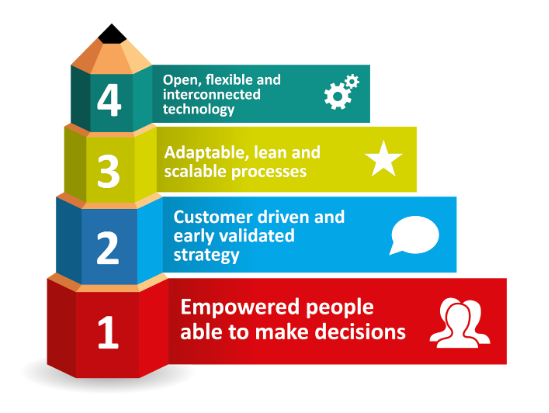Agile Transformation
How do you shift a legacy driven product and engineering department towards an effective agile organisation?
The primary objective of this project was to revolutionise the product and engineering department, transitioning it from a legacy-driven structure to a highly effective agile organisation. Spearheaded by a team of three members within the transformation steering committee, this initiative aimed to craft innovative strategies and operational frameworks tailored to the unique challenges faced by the company.
THE CHALLENGE
The company grappled with two interconnected challenges: intensifying competition and the shift towards becoming a multinational corporation. These challenges necessitated the development of software across diverse global locations, time zones and cultures.
Addressing these challenges required:
- Scaling capabilities to meet strategic demands
- Modernising the product portfolio and technical architecture
- Accelerating time-to-market
- Enhancing visibility and transparency of ongoing projects
- Adapting effectively to changing priorities
- Establishing synchronised, self-governing processes across locations
- Empowering technically adept teams to drive technology-driven solutions
- Aligning product development with business stakeholders
- Creating iterative development cycles focused on customer needs
- Fostering innovation through collaboration with stakeholders
- Cultivating a resilient mindset that embraces early failure and rapid learning
THE APPROACH
The project team meticulously assessed the organisational landscape, leadership dynamics, cultural aspects and individual commitment through surveys, observations, interviews and feedback mechanisms. This comprehensive evaluation informed the creation of a visionary blueprint encompassing mission, purpose, organisational structure and success factors. The subsequent planned activities were aimed at initiating the transformational journey.
The initial step involved establishing an Agile framework, defining roles, responsibilities, artefacts, and ceremonies pivotal for fostering Purpose, Mastery, and Autonomy within the department.

The transformation was segmented into four distinct work streams, each with an independent roadmap and dedicated stream owner:
- Technology: Conducting capability audits, future-proofing architecture, technology reviews, and supplier evaluations.
- Process: Reviewing internal processes, optimising tools and connectivity, implementing and governing Scrum processes.
- Product Strategy: Evaluating product development methods, prioritising backlog with lean thinking, and ensuring continuous alignment and communication.
- People: Assessing skills, reviewing organisational structure, providing leadership education, and mentoring teams.
THE SOLUTION
The restructured organisation adopted a customer- and product-centric strategy, comprising tribes and teams guided by strategic product leads. This reorganisation aimed to streamline decision-making processes, enabling scalable teams to swiftly address new product initiatives without hierarchical constraints.
Chapters were established to facilitate alignment, expertise, and support across specific functional areas or topics, fostering collaboration and synergy throughout the organisation.
The integration of technology within the product-focused organisation empowered it as the system owner, emphasising system integrity, quality, documentation, technical debt reduction, scalability, and release processes.
Technological advancements focused on robust test-driven environments, scalable hosting solutions, and future-proofing endeavours through decoupling initiatives and microservices infrastructure.
Customer data collection and analysis were prioritised within the technology stream to enhance efficiency and provide actionable insights for product leads. Additionally, a strong integration between UX and the data team enhanced customer interaction analysis, fuelling future innovation.
Successes included the introduction of People Managers responsible for team health, hiring initiatives, training, and career development, fostering a supportive environment within the organisation.
Furthermore, governance structures were implemented for hiring talent, updating HR processes, and introducing new training programs, emphasising continual people development.
KEY SUCCESS FACTORS
- Visionary outlook
- Consistent communication and transparency
- Segregation of disciplinary and strategic leadership goals
- Willingness to take calculated risks and make prompt decisions
- Strong executive commitment to embracing new technologies and infrastructure development
CONCLUSION
The success of this transformation resonates from its iterative goal-setting and constant reflection, which followed the crucial phase of garnering initial buy-in. The kick-off event received overwhelmingly positive feedback, reflecting a resounding satisfaction with the envisioned strategies, approach and meticulously crafted roadmaps. This culminated in an immensely successful and impactful transformational journey that reshaped the organisation’s core fabric.